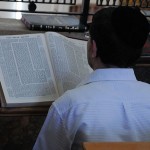Origins of yeshivot – Ask the Rabbi
Q. Why are Talmudical colleges called yeshivot? When did yeshivot begin?
 A. The term comes from a verb that means “to sit”. It indicates that intense study requires deep concentration.
A. The term comes from a verb that means “to sit”. It indicates that intense study requires deep concentration.
According to rabbinic tradition, yeshivah study began in ancient Biblical times under the auspices of Shem and Ever.
There were famous academies in the days of the Talmud, not necessarily for full-time students but for anyone who wanted to discover the inner meaning of the tradition.
Twice a year, during Adar and Ellul, when agricultural work had slowed down, the academies were crowded for adult education courses. These were known as kallah months, possibly because kallah is made up of the initial letters of k‘nesset lom’dei haTorah, “assembly of students of Torah”. Thereafter, in every Jewish community, the local rabbi would conduct a school for advanced students.
The purpose was not to train rabbis – the professional rabbinate did not emerge until the late Middle Ages – but to produce learned laymen. Some of these yeshivot attained a very high reputation. The yeshivah system ensured that intense Torah study would remain a top Jewish priority. (For more details, see Encyclopedia Judaica, vol. 16, s.v. “Yeshivot”).
It was not until the beginning of the 19th century that we see the modern yeshivah emerge, attracting students from out-of-town and sometimes developing an international reputation.
This was especially due to the followers of the Vilna Gaon, especially Reb Chayyim Volozhiner who established a great yeshivah in Volozhin (near Vilna), Lithuania, in 1802. His example was followed in other parts of Lithuania and elsewhere, in due course accompanying Talmud study with mussar sessions aiming to develop piety and ethical character amongst the students.
For a long period the yeshivot were mostly non-Chassidic, but eventually the Chassidic movement also built up an intellectual tradition; all groups within orthodoxy felt the need to counter the secularist trends of the Haskalah. Some yeshivah students were illuyim – intellectual prodigies; others could not take study at such a high level and some dropped out of orthodoxy altogether.
There were brave attempts to create yeshivot in central and western Europe, the United States and Britain; some, such as Gateshead in the north of England became world-famous.
In Israel a few great yeshivot came into being before the Second World War, sometimes transplanted from eastern Europe. An example is the Slobodka yeshivah which suffered greatly in the Hebron riots of 1929 and later moved to Jerusalem.
After the Holocaust, transplanted yeshivot in Israel bore the names of Mir, Ponieviezh, Pressburg, etc.; great yeshivot came into being in the United States; and the Talmudic tradition began to flourish in many other countries. In 1945 some critics wrote off orthodoxy and Talmud study, but their grim predictions have been confounded by the facts.
Early in the history of the State of Israel, David Ben Gurion agreed to grant generous conditions to yeshivot and Talmudic students in order to assist the revitalisation of orthodox tradition, though today there are complaints from some that the yeshivot and their students are proliferating to such an extent that thousands of students are shielded from the realities of economic life and national duty.
Whatever policies the Israeli government decides upon in this area, it is however undeniable that there are more serious students of Torah in Israel today than ever existed anywhere in Jewish history, even in eastern Europe and even in Babylon in Talmudic days.



